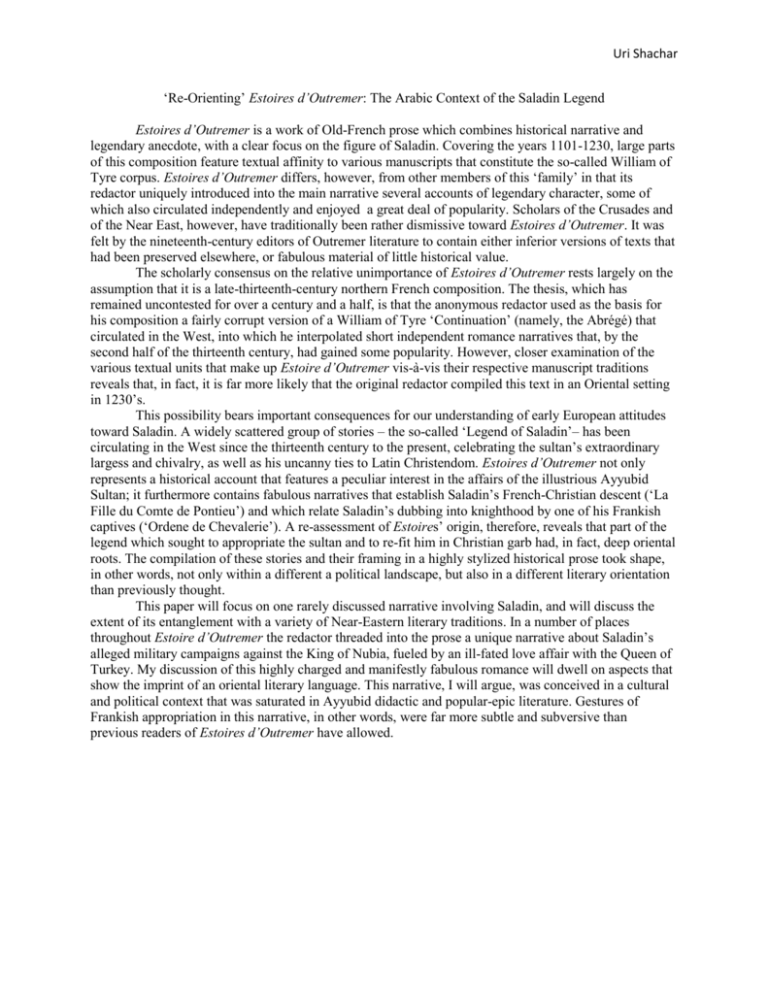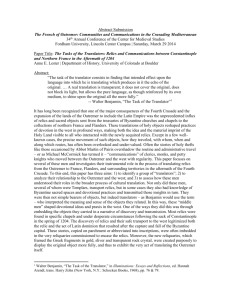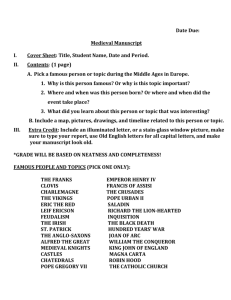Uri Shachar, University of Chicago Re
advertisement

Uri Shachar ‘Re-Orienting’ Estoires d’Outremer: The Arabic Context of the Saladin Legend Estoires d’Outremer is a work of Old-French prose which combines historical narrative and legendary anecdote, with a clear focus on the figure of Saladin. Covering the years 1101-1230, large parts of this composition feature textual affinity to various manuscripts that constitute the so-called William of Tyre corpus. Estoires d’Outremer differs, however, from other members of this ‘family’ in that its redactor uniquely introduced into the main narrative several accounts of legendary character, some of which also circulated independently and enjoyed a great deal of popularity. Scholars of the Crusades and of the Near East, however, have traditionally been rather dismissive toward Estoires d’Outremer. It was felt by the nineteenth-century editors of Outremer literature to contain either inferior versions of texts that had been preserved elsewhere, or fabulous material of little historical value. The scholarly consensus on the relative unimportance of Estoires d’Outremer rests largely on the assumption that it is a late-thirteenth-century northern French composition. The thesis, which has remained uncontested for over a century and a half, is that the anonymous redactor used as the basis for his composition a fairly corrupt version of a William of Tyre ‘Continuation’ (namely, the Abrégé) that circulated in the West, into which he interpolated short independent romance narratives that, by the second half of the thirteenth century, had gained some popularity. However, closer examination of the various textual units that make up Estoire d’Outremer vis-à-vis their respective manuscript traditions reveals that, in fact, it is far more likely that the original redactor compiled this text in an Oriental setting in 1230’s. This possibility bears important consequences for our understanding of early European attitudes toward Saladin. A widely scattered group of stories – the so-called ‘Legend of Saladin’– has been circulating in the West since the thirteenth century to the present, celebrating the sultan’s extraordinary largess and chivalry, as well as his uncanny ties to Latin Christendom. Estoires d’Outremer not only represents a historical account that features a peculiar interest in the affairs of the illustrious Ayyubid Sultan; it furthermore contains fabulous narratives that establish Saladin’s French-Christian descent (‘La Fille du Comte de Pontieu’) and which relate Saladin’s dubbing into knighthood by one of his Frankish captives (‘Ordene de Chevalerie’). A re-assessment of Estoires’ origin, therefore, reveals that part of the legend which sought to appropriate the sultan and to re-fit him in Christian garb had, in fact, deep oriental roots. The compilation of these stories and their framing in a highly stylized historical prose took shape, in other words, not only within a different a political landscape, but also in a different literary orientation than previously thought. This paper will focus on one rarely discussed narrative involving Saladin, and will discuss the extent of its entanglement with a variety of Near-Eastern literary traditions. In a number of places throughout Estoire d’Outremer the redactor threaded into the prose a unique narrative about Saladin’s alleged military campaigns against the King of Nubia, fueled by an ill-fated love affair with the Queen of Turkey. My discussion of this highly charged and manifestly fabulous romance will dwell on aspects that show the imprint of an oriental literary language. This narrative, I will argue, was conceived in a cultural and political context that was saturated in Ayyubid didactic and popular-epic literature. Gestures of Frankish appropriation in this narrative, in other words, were far more subtle and subversive than previous readers of Estoires d’Outremer have allowed.








